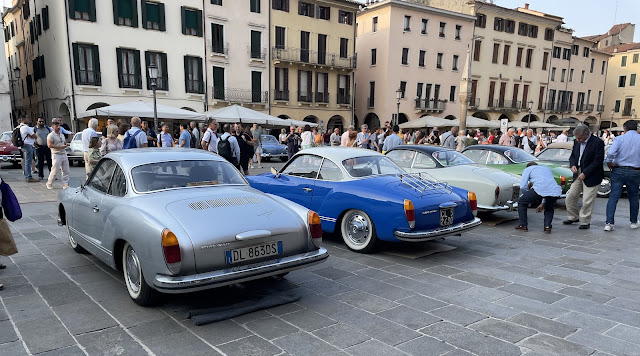Der italienische Karmann Ghia Club veranstaltet jedes Jahr ein größeres Treffen, lädt auch befreundete deutsche Besitzer des schicken Zweitürers ein. Wir trafen sie in Padua, wo die rund 40 Fahrzeuge in Zentrum die Blicke auf sich zogen.
von Achim und Edda Stahn
Hintergrundinformationen zur Entstehung bekamen wir auch, in Englisch. Mehr dazu weiter unten.
His early proposals (including sketches for a German-designed coupe) failed to convince Volkswagen’s management.
Karmann then looked abroad. In the design-conscious climate of the 1950s, Italian style was in vogue, so he turned to Carrozzeria Ghia of Turin, headed by Luigi Segre.
Segre himself was an unlikely character: a former OSS operative turned engineer who had become a savvy salesman and co-owner at Ghia. At postwar motor shows Karmann and Segre had “hit it off,” and in 1952 Karmann laid out his vision: take the sensible economy of the Beetle platform and marry it to “gorgeous Italian styling”.
Segre agreed to the challenge but with a condition: he would deliver more than sketches. Secretly, he and Felice Mario Boano began work on a physical prototype. By the summer of 1953 they had completed a fully trimmed clay model and body.
Segre agreed to the challenge but with a condition: he would deliver more than sketches. Secretly, he and Felice Mario Boano began work on a physical prototype. By the summer of 1953 they had completed a fully trimmed clay model and body.
Keeping the project under wraps, Segre arranged a surprise reveal: he invited Karmann and Volkswagen executives to Ghia’s facilities in France (to ensure secrecy) and unveiled a finished two-seat coupé design.
Faced with this stunning result – far more tangible than any drawing – Volkswagen was won over immediately.
“Volkswagen loved the little coupe,” the story goes, and the Karmann Ghia was born.
Italian Styling on a Beetle Chassis
The new car, internally designated the Type 14, combined VW’s proven floorpan and 1.2‑liter flat-four engine (36 hp) with Ghia’s flowing coachwork.
Italian Styling on a Beetle Chassis
The new car, internally designated the Type 14, combined VW’s proven floorpan and 1.2‑liter flat-four engine (36 hp) with Ghia’s flowing coachwork.
Its silhouette was an homage to the American showcars of the day.
With hand-welded, hand-filed sheetmetal, the body appeared almost seamless – the front end looked like one smooth piece, “swooping” back to a tapered tail. Observers noted that the Karmann Ghia’s shape bore a “striking resemblance” to Chrysler’s 1950s “dream cars.”
Virgil Exner’s son quipped that it was “a direct, intentional swipe off the Chrysler d’Elegance,” yet most fans adored the result. (In fact, Segre had worked with Exner and others on Chrysler prototypes, and many of the Karmann Ghia’s cues – such as the pointed fenders and wraparound stance – owe a debt to those Italian-American designs.
Despite its glamorous skin, the Karmann Ghia was fundamentally a Volkswagen mechanically. It rode on a slightly widened Beetle floorpan; the chassis was strengthened, but the wheels, suspension, and drivetrain were all VW components.
The coupe sat lower than a Beetle, giving it a lower center of gravity. This yielded noticeably better handling: the Ghia felt more responsive in corners and even gained about 10 mph in top speed over the Beetle. Volkswagen’s marketing was honest: they insisted this was not a raw sports car but an “absolutely stylish sports-minded touring car.” It could keep pace with traffic, but its real appeal was timeless style and quality.
Ghia designer Sergio Sartorelli would later add a light facelift in 1959 (sharpening the body lines), and in 1961 American designer Tom Tjaarda joined to refine the next generation (the Type 34). But in its original form the Type 14’s coachwork was a groundbreaking exercise in European craft. Each of the pressed panels required meticulous work.
According to one contemporary account, every Karmann Ghia body underwent dozens of welds and hand filings until “the finished body did not reveal a seam or weld line anywhere,” with as many as 200 inspectors handling each car on the line. This labor-intensive process ensured the car’s graceful curves were flawless but also meant Ghias were never built in the high volumes of simpler cars.
Production and Launch of the Type 14
With Ghia’s design approved, and the first prototype built, Karmann set up production next to its Volkswagen convertible lines in Osnabrück. In mid‑1954 VW agreed to supply Karmann with Beetle chassis, and work proceeded on tooling and jigs.The coupé and convertible (which was produced starting from 1957) body panels were hand-crafted and extensively lead- and fill‑sanded to eliminate panel gaps. Finally, the new car was ready for the world.
The press launch took place on 14 July 1955 near Osnabrück, and in September 1955 the Frankfurt International Motor Show saw the official public debut. Witnesses wrote that dealers and journalists were instantly captivated by the Ghia’s combination of Beetle reliability with a fresh, European sports-car flair. want to know more
Tipps zur Blog-Nutzung
Alles rund um unsere Mobilität: Autos, Bikes, Räder, Reisen mit zwei und vier Rädern,
Nutzfahrzeuge, Insider-Tipps, Motorsport, Verkehrsrecht und vieles mehr.
Zur Startseite dieses Blogs geht es hier:
https://mobilitaet-heute.blogspot.com
Einfache Themensuche
1. oben im Blog mit der Lupe
(Suchwort eingeben, alles dazu wird gezeigt)
2. Kästen am Textende anklicken
Interessantes senden an:
achim.stahn@interpress-ipr.de









Kommentare
Kommentar veröffentlichen